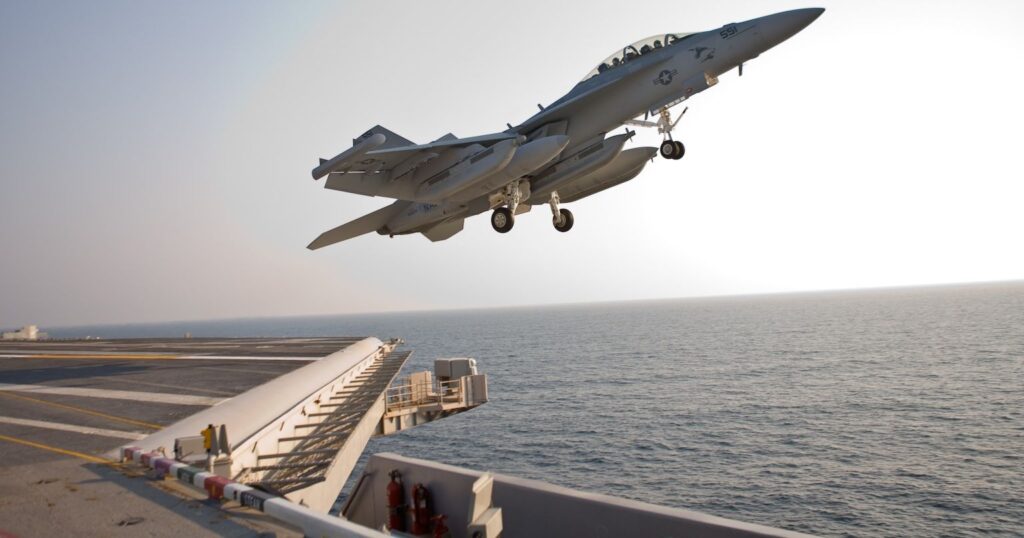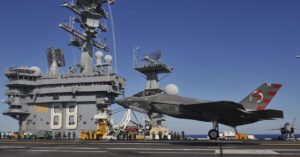
CAPITOL HILL: Pentagon leaders are pushing hard to keep up the momentum of the F-35 Joint Strike Fighter. Many in the Navy, though, still look longingly back at the Boeing-builtF-18 Hornet, whose St. Louis production line faces closure in 2017. There are two independent trends that together could save the St. Louis line and the Navy’s favorite plane.
The first is the growing shortfall in electronic warfare, a gap most easily filled with more EA-18G Growlers, a Hornet variant and the military’s only high-performance jamming aircraft currently in production. (The F-35C, the Navy variant of the Joint Strike Fighter, has some significant jamming capability but won’t be ready for Initial Operational Capability by August 2018, and no later than February 2019.) The second is the accelerated aging of the Navy fighter fleet, a gap most easily filled by F/A-18E/F Super Hornets given recent reductions in the number of F-35Cs the Navy plans to buy.
The Navy has long been ambivalent about the F-35C. “They’re under a lot of pressure from OSD to fall in line on F-35C and they’ll certainly get some,” aviation analyst Richard Aboulafia told me, “[but] given the price differential between current year F-35s and Super Hornets, and their reluctance to lose their only all-Navy plane, there’s a strong attraction for keeping the [St. Louis] line going as long as possible.”
Ordering either more Super Hornets or more Growlers would keep the line alive, and buying more of one would keep open the option to buy more of the other later. “It happens to be made by the same company,” Adm. Jonathan Greenert told me. “It’s the same airframe.”
The interlinked issues are complex enough that Greenert and his press aide pulled me aside after today’s Senate Appropriations hearing to make sure I understood what he’d told the subcommittee and other reporters.

First, Deputy Defense Secretary Bob Workis overseeing a study of electronic warfare requirements across the entire military. Since the Growler carries the primary jammer for all four services, that study has particular significance for the Navy, which is worried it won’t have enough jamming capacity. In fact, Greenert had asked the other services to give him their jamming requirements last year, during the development of the 2016 budget request. That analysis didn’t get done in time for February’s budget release, so it got rolled into Work’s wider “strategic portfolio review.”
“That’s an OSD-led thing. It’ll go into the summer review as we build the ’17 budget,” Greenert told me. “My job will be to say, ‘Okay, guys. We didn’t do this last year. We have to get an unambiguous answer on the aircraft.’”
That is, I asked, before the Growler line goes away?
“Yes,” Greenert said emphatically.
In parallel to Work’s review is a separate, parallel Navy process to figure out how to fix the Navy’s aging fighter fleet. After all the disruptions of 2013 — “sequestration… a hiring freeze… furloughs…no overtime,” Greenert recounted — the military’s maintenance depots fell badly behind. For Navy and Marine aircraft, that backlog was compounded by the discovery that the fleet’s oldest fighters, the F-18A, B, C, and D “legacy” Hornets, had suffered more corrosion and required more repair work than the service had planned on.
Before 2013, the Navy had planned an ambitious program to keep some of the A/B/C/D Hornets flying for 10,000 hours — an impressive 67 percent increase from the 6,000 hours the aircraft were designed to last. But since the 2013 sequester, the depots just can’t fix up the old fighters fast enough. That means fewer legacy F-18A/B/C/D Hornets were available for operations and training, which means the newer F/A-18E/F Super Hornet had to fly more hours, which in turn means the Super Hornets started wearing out faster than planned. Overall, Greenert estimates, the Navy might eventually end up short as many as three fighter squadrons, about 36 aircraft.
The depots are picking up the pace (which will end if sequester strikes again), but it will take until roughly May next year to figure out the full extent of the problem, Greenert told me. “15 months,” he said. “I think it’ll take me about that long to really look at the Hornet situation, to determine how’re we doing at getting these legacy Hornets — the A through D [models] — out of the depots [and] back into the fleet, so that they’re taking the pressure off the Super Hornets.”
In theory, the Navy has two options. It could retire some of the oldest legacy Hornets ahead of time and replace them with additional Super Hornets, which also would make up for existing Super Hornets that will wear out early from the current pace of operations. Or the Navy could replace legacy Hornets with F-35C Joint Strike Fighters.

The problem with the F-35 option, however, is that the program is behind schedule and the Pentagon has already slowed the pace of production in its current budget plan. The Super Hornet, by contrast, is currently in production — as is the Growler.
The Navy likes this two-pronged, two-plane approach. Unlike the Air Force, which has bet everything on the F-35’s ability to do both physical and electronic attacks, the Navy prefers to keep building specialized fighters like the Super Hornet and specialized jammers like the Growler.
A formation made purely of F-35s may be able to protect itself electronically, Greenert said, but that doesn’t mean F-35s can adequately protect other aircraft. While the Air Force believes the F-35’s combination of stealth and electronic warfare capability are superior to the Growler for the first days of a major war, the Navy thinks that such a high-intensity, high-tech fight is precisely where dedicated jamming aircraft will be most needed.
“When [F-35] goes out unto itself…they’re fine on electronic attack,” Greenert told reporters after today’s hearing. “When they gather together in a package” — that is, multiple types of aircraft, stealthy and unstealthy, operating together — and you needbroader electronic warfare/electronic attack/suppression, then… the pods on the Growlers, they can expand that beyond what an individual F-35 will do.”
The huge importance that Pentagon leadership places on the F-35, however, makes it politically difficult for the Navy to fund what’s seen as competing aircraft. Air Force leaders argue the F-35 is able to provide directed cyber and electronic warfare capabilities the Growler’s pods cannot match; in fact, they say, the Growlers’ pods are too powerful and unsubtle in some situations. But it is the Super Hornet that really is going head-to-head with the F-35, since both are fighters.
“In terms of military need, the Navy has so far made a reasonable case that additional EA-18Gs could prove useful in the future,” one Hill staffer said. “[But] restarting the F/A-18E/F line would likely be seen as putting Navy F-35C production rates at risk, so I would expect that to be a major fight inside the Pentagon.”
That means Growlers have a decent shot. But of course, that assumes anyone can find money to buy more planes. “If the four defense committees get to markup bills at the president’s budget level, then additional EA-18Gs are definitely in play,” the Hill staffer said. “If they mark below the [president’s budget request], then adding enough funding to keep the line open for another year — probably at least $1.2 billion — could be very difficult.”
